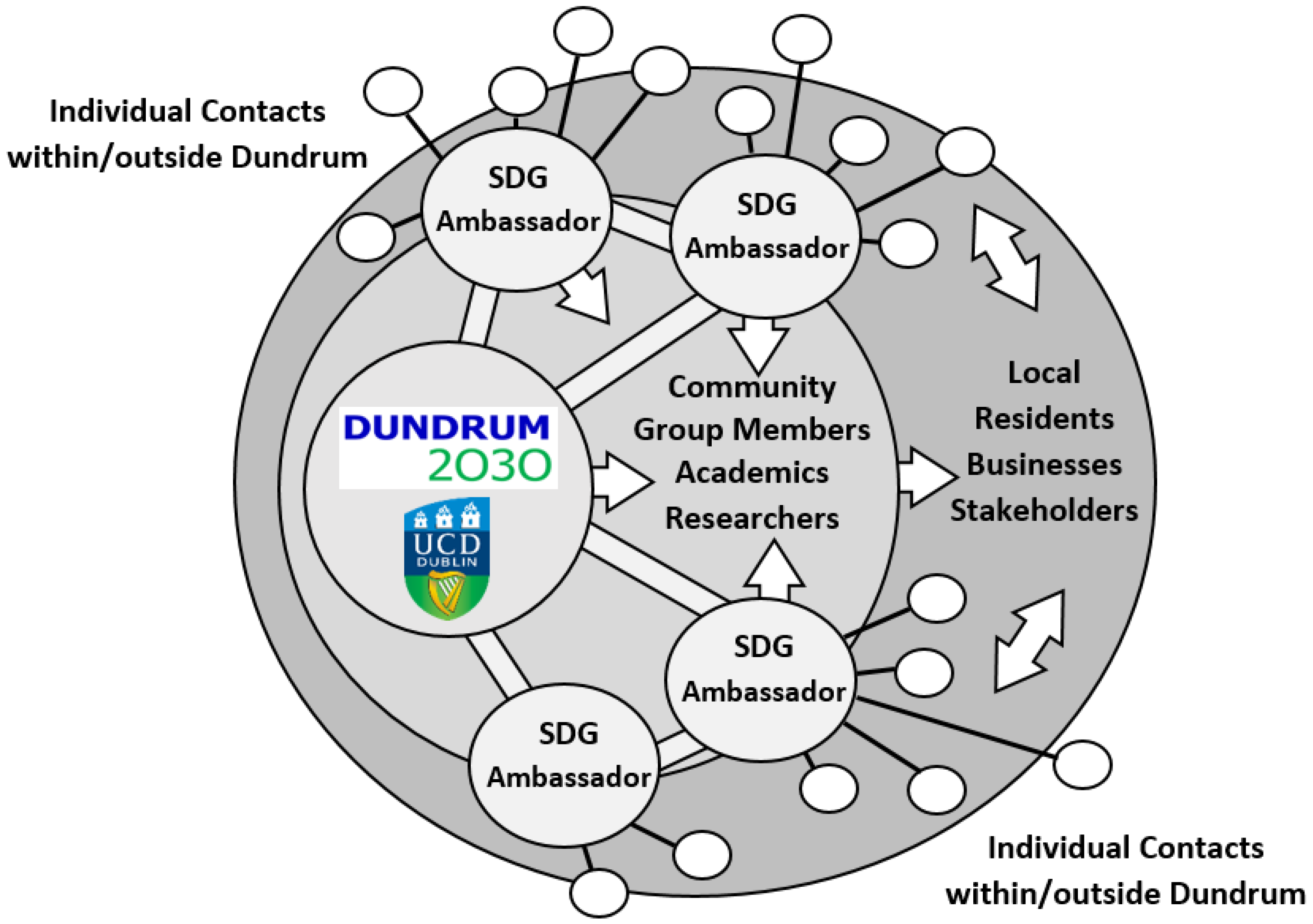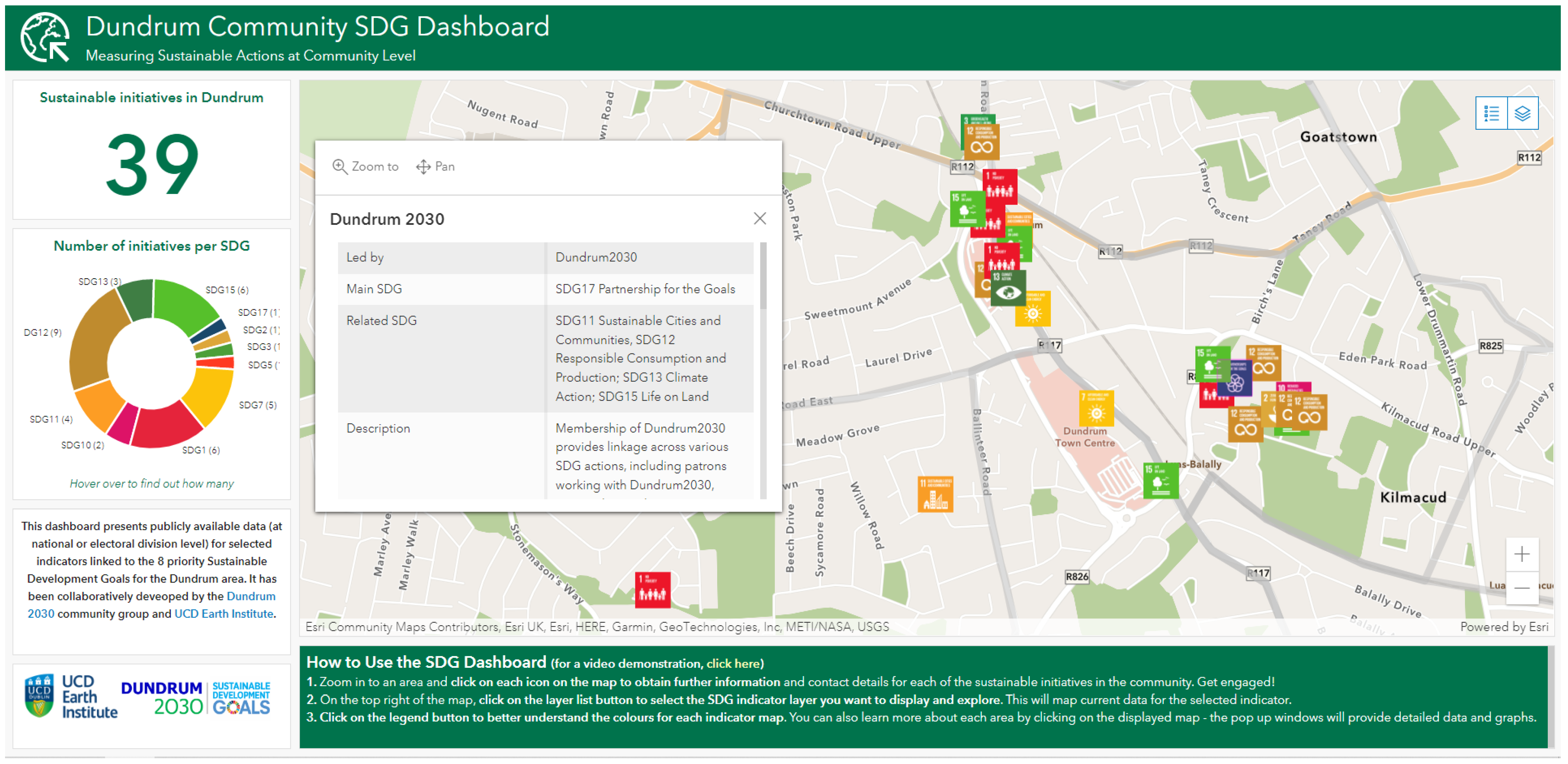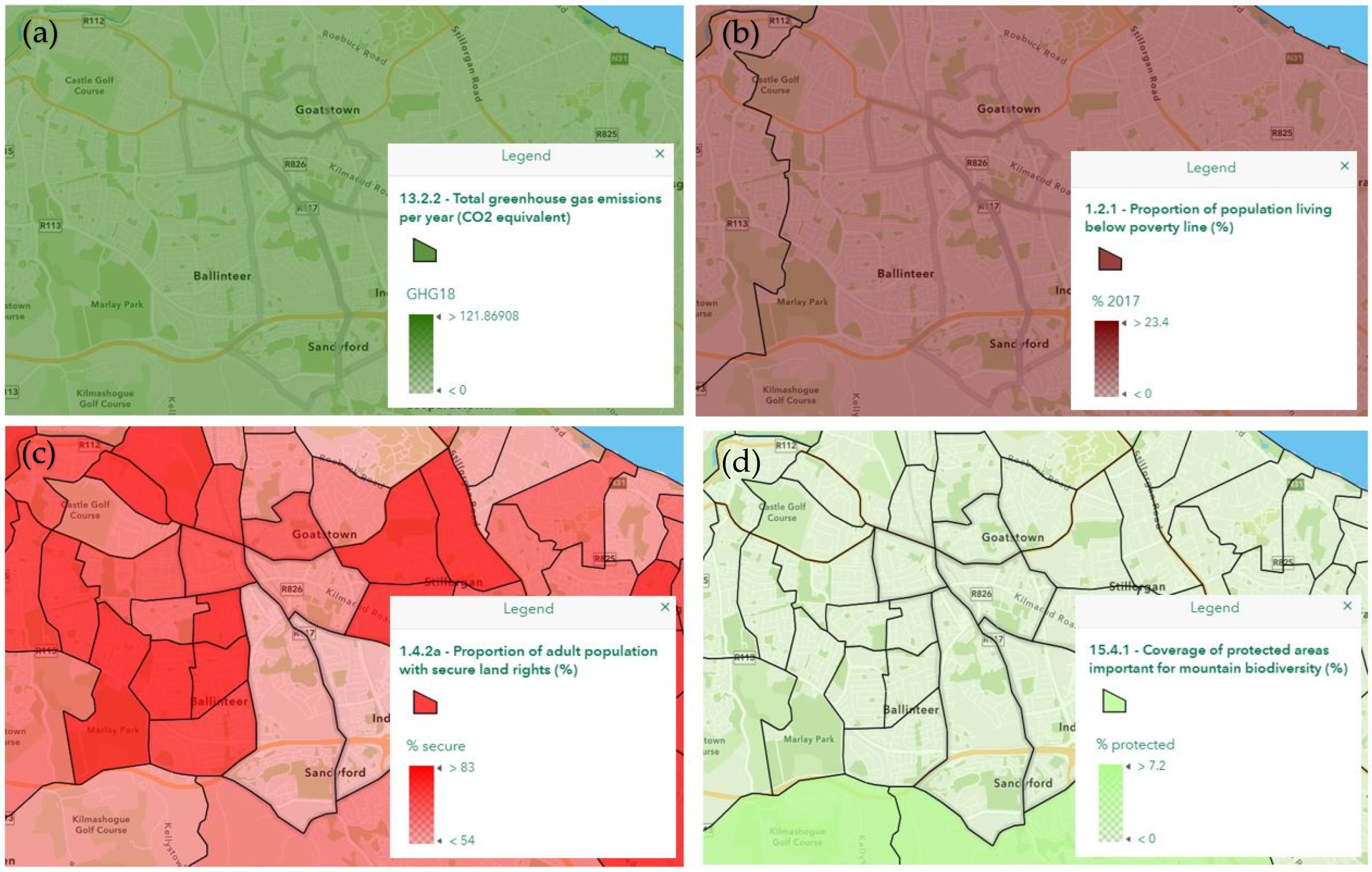Priorities, Scale and Insights: Opportunities and Challenges for Community Involvement in SDG Implementation and Monitoring
Abstract
:1. Introduction
1.1. SDG Indicator Monitoring and Data Challenges
1.2. Bridging National and Local Data for SDG Indicator Reporting
2. The Community SDG Dashboard Framework: A Partnership for the Goals
3. Methods
4. Results
4.1. Selection of Priority SDGs and Indicators
4.2. Mapping Selected SDG Indicators
- Some desired indicators are currently only gathered and reported at national level (e.g., SDG indicator 13.2.2 “Total greenhouse gas emissions per year”; or indicator 17.1.1 “Total government revenue as a proportion of GDP, by source”), affecting local scale insights.
- Four indicators are currently published at national level despite their association with percentage area or percentage population. For these indicators, finer resolution (i.e., local scale) maps were obtained by recalculating national data for “Small Areas” (the smallest census unit in Ireland, generally comprising between 80 and 120 dwellings) using area extent or population statistics as appropriate.
- The Central Statistics Office (CSO) collects detailed census data relevant to some of the indicators (e.g., 1.4.2, 11.2.1, 17.6.1, and 17.8.1). The project team contacted the CSO in search of more granular detail that could better inform the Dundrum 2030 community group. However, due to General Data Protection Regulation (GDPR) restrictions, such data could not be made available at finer resolutions than those published publicly.
- The CSO has a new environmental division created in 2015 to comply with Eurostat legal and voluntary reporting obligations. Some of the selected indicators could benefit from their new data collection initiatives such as annual business energy use surveys and biennial recycling and waste generation surveys. Yet, such data collection is currently generalised to administrative county and national levels, respectively, affecting data scale and thus failing to capture local contributions to waste generation and recycling or, indeed, commercial and household energy use.
- Where a UN-aligned indicator includes several data reporting components, it is not always clear which component of the indicator the national data reporting relates to. For example, data for indicator 1.4.2 (“Proportion of total adult population with secure tenure rights to land, (a) with legally recognised documentation, and (b) who perceive their rights to land as secure, by sex and type of tenure”) do exist, but it is unclear whether the data reported are for component (a) or (b). Similarly, 12.b.1. (“Implementation of standard accounting tools to monitor the economic and environmental aspects of tourism sustainability”) is reported at national level by UN Statistics, but lists data for only two of these metrics (i.e., System of Environmental Economic Accounting tables present and number of tables).
- Compromise was sometimes required between the age of data, compatibility of the data with UN-aligned indicators, and spatial resolution. For example, 11.2.1 (“Proportion of population that has convenient access to public transport, by sex, age and persons with disabilities”) data are provided up to 2016 and have been collected at the “Dublin City and Suburbs” resolution, an arbitrary spatial delineation which does not align with the geographical scale of any other dataset. A newer dataset at a compatible spatial resolution is hosted by the Sustainable Development Solutions Network (SDSN) as a national index. However, closer inspection reveals that this is in fact data on “satisfaction with public transport”. In this case, the older dataset was used, but was spatially clipped to compatible administrative areas (i.e., regional boundaries) for easier and comparable dashboard visualisation.
- Some indicators, especially concerning land-use (e.g., 11.7.1 “Average share of the built-up area of cities that is open space for public use for all, by sex, age and persons with disabilities”), could be readily derived from spatial data held by public authorities but inconsistencies in data collection methods, scale, and timing affect their homogenisation.
5. Discussion: Data Scale and Management Challenges Influencing Community Involvement
6. Concluding Remarks
Supplementary Materials
Author Contributions
Funding
Institutional Review Board Statement
Informed Consent Statement
Data Availability Statement
Acknowledgments
Conflicts of Interest
References
- UN (United Nations). Transforming Our World: The 2030 Agenda for Sustainable Development, A/RES/70/1. 2015. Available online: https://digitallibrary.un.org/record/3923923?ln=en (accessed on 2 February 2023).
- EC (European Commission). The New European Consensus on Development ‘Our World, Our Dignity, Our Future’. 2018. Available online: https://op.europa.eu/en/publication-detail/-/publication/5a95e892-ec76-11e8-b690-01aa75ed71a1 (accessed on 2 February 2023).
- PIFS (Pacific Islands Forum Secretariat). Pacific Regional Education Framework (PacREF) 2018–2030: Moving Towards Education 2030. 2018. Available online: https://www.forumsec.org/wp-content/uploads/2018/10/Pacific-Regional-Education-Framework-PacREF-2018-2030.pdf (accessed on 2 February 2023).
- EU (European Commission). Europe’s Approach to Implementing the Sustainable Development Goals: Good Practices and the Way Forward. European Union, Policy Department, Directorate-General for External Policies. 2019. Available online: https://www.europarl.europa.eu/cmsdata/160320/SDG%20study_formatted.pdf (accessed on 2 February 2023).
- Sankoh, O. Why population-based data are crucial to achieving the sustainable development goals. Int. J. Epidemiol. 2017, 46, 4–7. [Google Scholar] [CrossRef] [PubMed] [Green Version]
- Fritz, S.; See, L.; Carlson, T.; Haklay, M.; Oliver, J.L.; Fraisl, D.; Mondardini, R.; Bocklehurst, M.; Shanley, L.A.; Schade, S.; et al. Citizen science and the United Nations sustainable development goals. Nat. Sustain. 2019, 2, 922–930. [Google Scholar] [CrossRef] [Green Version]
- Murphy, E.; Walsh, P.P.; Banerjee, A. Framework for Achieving the Environmental Sustainable Development Goals. Environmental Protection Agency—Research Report. 2021. Available online: https://www.epa.ie/publications/research/climate-change/Research_Report_397_eb.pdf (accessed on 6 March 2023).
- Ajates, R.; Hager, G.; Georgiadis, P.; Coulson, S.; Woods, M.; Hemment, D. Local action with global impact: The case of the GROW observatory and the Sustainable Development Goals. Sustainability 2020, 12, 10518. [Google Scholar] [CrossRef]
- Daguitan, F.; Mwangi, C.; Tan, M.G.; Clark, G.; Cooper, D.; Donovan, J.M.; Gutierrez, S.; Kruglikova, N.; Lehohla, P.; Seager, J.; et al. Future data and knowledge needs. In Global Environment Outlook—GEO-6: Healthy Planet, Healthy People; UN Environment: Nairobi, Kenya, 2019; Available online: https://wedocs.unep.org/handle/20.500.11822/27539 (accessed on 6 March 2023).
- Hopp, D.; Fu, E.; Peltola, A. Feasibility of nowcasting SDG indicators: A comprehensive survey. United Nations Conference on Trade and Development, UNCTAD Research Paper No. 82 UNCTAD/SER.RP/2022/2. 2022. Available online: https://unctad.org/webflyer/feasibility-nowcasting-sdg-indicators-comprehensive-survey (accessed on 6 March 2023).
- MacFeely, S. The big (data) bang: Opportunities and challenges for compiling SDG indicators. Glob. Policy 2019, 10, 121–133. [Google Scholar] [CrossRef] [Green Version]
- UN Statistical Division. 2022. Available online: https://unstats.un.org/sdgs/iaeg-sdgs/tier-classification/ (accessed on 6 March 2023).
- Fisher, A.; Fukuda-Parr, S. Introduction—Data, knowledge, politics and localizing the SDGs. J. Hum. Dev. Capab. 2019, 20, 375–385. [Google Scholar] [CrossRef] [Green Version]
- MacFeely, S.; Nastav, B. “You say you want a [data] revolution”: A proposal to use unofficial statistics for the SDG global indicator framework. Stat. J. IAOS 2019, 35, 309–327. [Google Scholar] [CrossRef] [Green Version]
- Satterthwaite, M.L.; Dhital, S. Measuring access to justice: Transformation and technicality in SDG 16.3. Glob. Policy 2019, 10, 96–109. [Google Scholar] [CrossRef] [Green Version]
- Saner, R.; You, L.; Nguyen, M. Monitoring the SDGs: Digital and social technologies to ensure citizen participation, inclusiveness and transparency. Dev. Policy Rev. 2019, 38, 483–500. [Google Scholar] [CrossRef]
- Winkler, I.T.; Satterthwaite, M.L. Leaving no one behind? Persistent inequalities in the SDGs. Int. J. Hum. Rights 2017, 21, 1073–1097. [Google Scholar] [CrossRef]
- Woods, S.M.; Daskolia, M.; Joly, A.; Bonnet, P.; Soacha, K.; Liñan, S.; Woods, T.; Piera, J.; Ceccaroni, L. How networks of citizen observatories can increase the quality and quantity of citizen-science-generated data used to monitor SDG indicators. Sustainability 2022, 14, 4078. [Google Scholar] [CrossRef]
- Theobald, E.J.; Ettinger, A.K.; Burgess, H.K.; DeBey, L.B.; Schmidt, N.R.; Froehlich, H.E.; Wagner, C.; Hille Ris Lambers, J.; Tewksbury, J.; Harsch, M.A.; et al. Global change and local solutions: Tapping the unrealized potential of citizen science for biodiversity research. Biol. Conserv. 2015, 181, 236–244. [Google Scholar] [CrossRef] [Green Version]
- McKinley, D.C.; Miller-Rushing, A.J.; Ballard, H.L.; Bonney, R.; Brown, H.; Cook-Patton, S.C.; Evans, D.M.; French, R.A.; Parrish, J.K.; Phillips, T.B.; et al. Citizen Science can improve conservation science, natural resource management, and environmental protection. Biol. Conserv. 2017, 208, 15–28. [Google Scholar] [CrossRef] [Green Version]
- Fraisl, D.; Campbell, J.; See, I.; Wehn, U.; Wardlaw, J.; Gold, M.; Moorthy, I.; Arias, R.; Piera, J.; Oliver, J.L.; et al. Mapping citizen science contributions to the UN Sustainable Development Goals. Sustain. Sci. 2020, 15, 1735–1751. [Google Scholar] [CrossRef]
- Moczek, N.; Voigt-Heucke, S.L.; Mortega, K.G.; Fabó Cartas, C.; Knobloch, J. A self-assessment of European citizen science projects on their contribution to the UN Sustainable Development Goals (SDGs). Sustainability 2021, 13, 1774. [Google Scholar] [CrossRef]
- Shulla, K.; Filho, W.L.; Sommer, J.H.; Lange Salvia, A.; Borgemeister, C. Channels of collaboration for citizen science and the sustainable development goals. J. Clean. Prod. 2020, 264, 121735. [Google Scholar] [CrossRef]
- Head, J.S.; Crockatt, M.E.; Didarali, Z.; Woodward, M.; Emmett, B.A. The role of citizen science in meeting SDG targets around soil health. Sustainability 2020, 12, 10254. [Google Scholar] [CrossRef]
- Boza, M.E. SDG Dashboards: The Role of Information Tools in the Implementation of the 2030 Agenda. Report Prepared for UNDP-SIGOB and UNDP Bangkok Hub. 2017. Available online: https://statswiki.unece.org/download/attachments/128451803/SDG%20Dashboards%20UNDP-SIGOB.pdf?version=1&modificationDate=1527759534624&api=v2 (accessed on 6 March 2023).
- Zhilin, L.; Gong, X.; Chen, J.; Mills, J.; Songnian, L.; Zhu, X.; Peng, T.; Hao, W. Functional requirements of systems for visualization of Sustainable Development Goal (SDG) indicators. J. Geovis. Spat. Anal. 2020, 4, 5. [Google Scholar] [CrossRef]
- Dundrum 2030. 2022. Available online: https://dundrumtwentythirty.com/ (accessed on 6 March 2023).
- González, A.; Mc Guinness, S.; Murphy, E.; Kelliher, G.; Hagin-Meade, L. Partnering locally to monitor changes towards the achievement of SDGs. In Partnerships for Sustainable Development; Murphy, E., Banerjee, A., Walsh, P.P., Eds.; Springer Nature: Cham, Switzerland, 2022. [Google Scholar]
- Ballerini, L.; Bergh, S.I. Using citizen science data to monitor the Sustainable Development Goals: A bottom-up analysis. Sustain. Sci. 2021, 16, 1945–1962. [Google Scholar] [CrossRef]



| Tier I: 136 indicators In this tier, the SDG indicator is conceptually clear, has an internationally established methodology and standards, and data are regularly produced by countries (for at least 50% of countries) in every region where the indicator is relevant. |
| Tier II: 91 indicators The SDG indicator is conceptually clear, has an internationally established methodology, and standards are available, but the data are not regularly produced by countries. |
| Tier III: 0 indicators No internationally established methodology or standards are yet available for the indicator, but methodology/standards are being (or will be) developed or tested by the UN agency responsible for the specific indicator. |
| SDG Indicator | SDG Target | Data Source | Resolution | Year |
|---|---|---|---|---|
| 1.2.1 “Proportion of population living below the national poverty line, by sex and age” TIER I | 1.2 By 2030, reduce at least by half the proportion of men, women, and children of all ages living in poverty in all its dimensions according to national definitions | Sustainable Development Solutions Network (SDSN) (https://www.unsdsn.org/) + Central Statistics Office (CSO) (https://www.cso.ie/en/index.html) | Regional | 2019 |
| 1.4.2 “Proportion of total adult population with secure tenure rights to land, (a) with legally recognised documentation, and (b) who perceive their rights to land as secure, by sex and type of tenure” TIER II | 1.4 By 2030, ensure that all men and women, in particular the poor and the vulnerable, have equal rights to economic resources, as well as access to basic services, ownership and control over land and other forms of property, inheritance, natural resources, appropriate new technology and financial services, including microfinance | Ordnance Survey—Geohive (https://www.geohive.ie/) | Small Areas | 2016 |
| 1.a.2 “Proportion of total government spending on essential services (education, health and social protection)” TIER II | 1.a Ensure significant mobilisation of resources from a variety of sources, including through enhanced development cooperation, to provide adequate and predictable means for developing countries, in particular least developed countries, to implement programmes and policies to end poverty in all its dimensions | United Nations Statistics (UN Stats) (https://unstats.un.org/home/) + CSO | National | 2020 |
| 7.2.1 “Renewable energy share in the total final energy consumption” TIER I | 7.2 By 2030, increase substantially the share of renewable energy in the global energy mix | CSO + Geohive | National | 2019 |
| 10.2.1 “Proportion of people living below 50 per cent of median income, by sex, age and persons with disabilities” TIER II | 10.2 By 2030, empower and promote the social, economic and political inclusion of all, irrespective of age, sex, disability, race, ethnicity, origin, religion, or economic or other status | UN Stats + SDSN | National | 2016 |
| 11.2.1 “Proportion of population that has convenient access to public transport, by sex, age and persons with disabilities” TIER II | 11.2 By 2030, provide access to safe, affordable, accessible, and sustainable transport systems for all, improving road safety, notably by expanding public transport, with special attention to the needs of those in vulnerable situations, women, children, persons with disabilities, and older persons | CSO + SDSN | Regional | 2016 |
| 12.2.2 “Domestic material consumption, domestic material consumption per capita, and domestic material consumption per GDP” TIER I | 12.2 By 2030, achieve the sustainable management and efficient use of natural resources | UN Stats | National | 2017 |
| 12.3.1 “(a) Food loss index and (b) food waste index” TIER II | 12.3 By 2030, halve per capita global food waste at the retail and consumer levels and reduce food losses along production and supply chains, including post-harvest losses | Geohive | Regional (county) | 2012 |
| 12.b.1 “Implementation of standard accounting tools to monitor the economic and environmental aspects of tourism sustainability” TIER I | 12.b Develop and implement tools to monitor sustainable development impacts for sustainable tourism that creates jobs and promotes local culture and products | UN Stats | National | 2019 |
| 13.2.2 “Total greenhouse gas emissions per year” TIER I | 13.2 Integrate climate change measures into national policies, strategies, and planning | UN Stats | National | 2018 |
| 15.1.2 “Proportion of important sites for terrestrial and freshwater biodiversity that are covered by protected areas, by ecosystem type” TIER I | 15.1 By 2020, ensure the conservation, restoration, and sustainable use of terrestrial and inland freshwater ecosystems and their services, in particular forests, wetlands, mountains and drylands, in line with obligations under international agreements | UN Stats | National (recalculated for the local level using area statistics) | 2019 |
| 15.4.1 “Coverage by protected areas of important sites for mountain biodiversity” TIER I | 15.4 By 2030, ensure the conservation of mountain ecosystems, including their biodiversity, in order to enhance their capacity to provide benefits that are essential for sustainable development | UN Stats | National (recalculated for the local level using area statistics) | 2018 |
| 17.1.1 “Total government revenue as a proportion of GDP, by source” TIER I | 17.1 Strengthen domestic resource mobilization, including through international support to developing countries, to improve domestic capacity for tax and other revenue collection | UN Stats | National | 2019 |
| 17.6.1 “Fixed Internet broadband subscriptions per 100 inhabitants, by speed” TIER I | 17.6 Enhance North–South, South–South and triangular regional and international cooperation on and access to science, technology, and innovation and enhance knowledge-sharing on mutually agreed terms, including through improved coordination among existing mechanisms, in particular at the United Nations level, and through a global technology facilitation mechanism | Geohive | National (recalculated for the local level using population statistics) | 2016 |
| 17.8.1 “Proportion of individuals using the Internet” TIER I | 17.8 Fully operationalise the technology bank and science, technology, and innovation capacity-building mechanism for least developed countries by 2017 and enhance the use of enabling technology, in particular information and communications technology | Geohive | National (recalculated for the local level using population statistics) | 2016 |
Disclaimer/Publisher’s Note: The statements, opinions and data contained in all publications are solely those of the individual author(s) and contributor(s) and not of MDPI and/or the editor(s). MDPI and/or the editor(s) disclaim responsibility for any injury to people or property resulting from any ideas, methods, instructions or products referred to in the content. |
© 2023 by the authors. Licensee MDPI, Basel, Switzerland. This article is an open access article distributed under the terms and conditions of the Creative Commons Attribution (CC BY) license (https://creativecommons.org/licenses/by/4.0/).
Share and Cite
González, A.; Mc Guinness, S.; Murphy, E.; Kelliher, G.; Hagin-Meade, L. Priorities, Scale and Insights: Opportunities and Challenges for Community Involvement in SDG Implementation and Monitoring. Sustainability 2023, 15, 4971. https://doi.org/10.3390/su15064971
González A, Mc Guinness S, Murphy E, Kelliher G, Hagin-Meade L. Priorities, Scale and Insights: Opportunities and Challenges for Community Involvement in SDG Implementation and Monitoring. Sustainability. 2023; 15(6):4971. https://doi.org/10.3390/su15064971
Chicago/Turabian StyleGonzález, Ainhoa, Shane Mc Guinness, Enda Murphy, Grainne Kelliher, and Lyn Hagin-Meade. 2023. "Priorities, Scale and Insights: Opportunities and Challenges for Community Involvement in SDG Implementation and Monitoring" Sustainability 15, no. 6: 4971. https://doi.org/10.3390/su15064971






